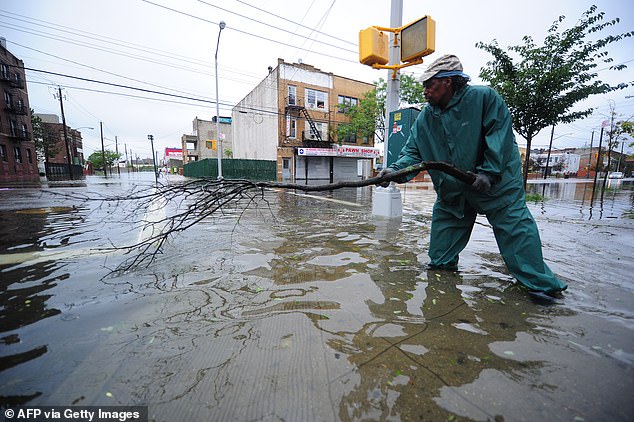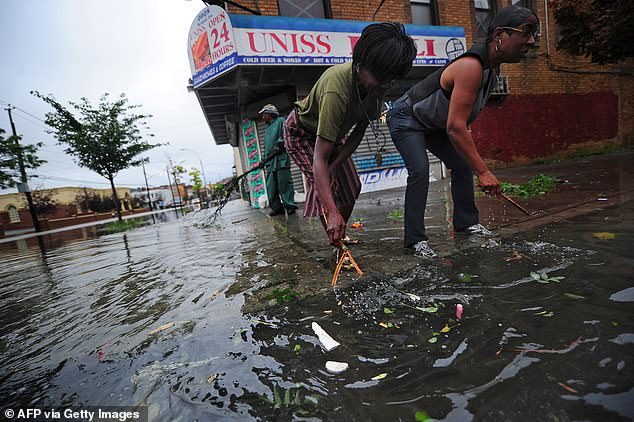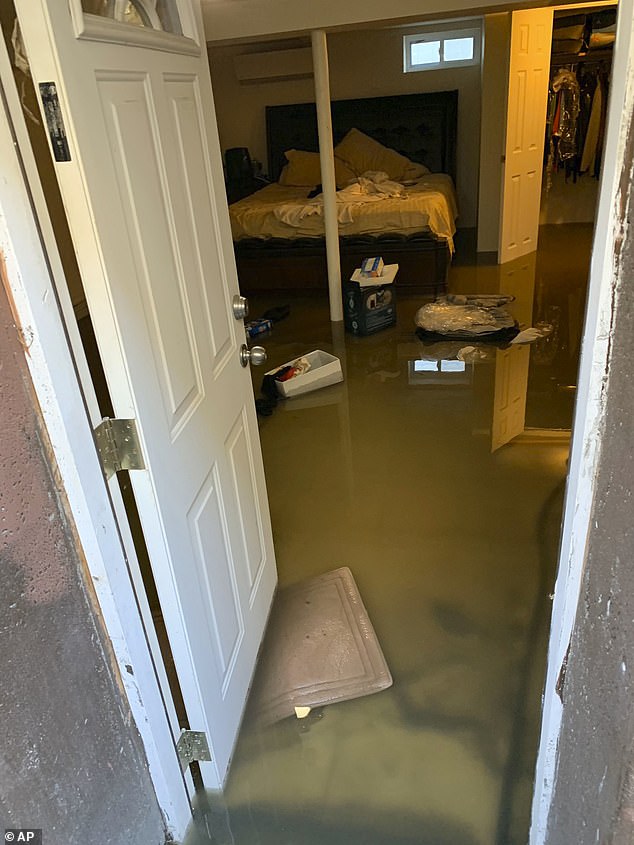Major US cities including NYC, Boston and Philadelphia could be ‘inundated’ by floods of raw SEWAGE, study reveals
Major coastal cities including New York City, Boston and Philadelphia could be “inundated” by untreated sewage flowing into streets and basements, a study warns.
Scientists found that the pipe networks dating from the mid-1850s, combined with rising sea levels and increasing rainfall, are overloading the systems and causing sewage to flood the streets.
The pipes originally discharged into streams and rivers, after which they were diverted to sewage treatment plants running through cities.
The systems are also designed to handle up to 1.7 inches of rainfall per hour, for example in areas like New York City.
But new models predict that more than two inches of rain could fall per hour over the next thirty years.
Older coastal cities like New York City, Boston and Philadelphia could be “inundated” by untreated sewage that floods streets and basements. Pictured: Boston residents experienced coastal flooding during heavy rains in January 2024

New York City is one of the largest metropolitan areas at risk of sewage flooding because its pipes, built in the mid-1850s, were unable to handle rainfall of more than 1.75 inches per hour. Pictured: Man tries to unclog a sewer grate after Hurricane Irene hit Coney Island in 2011
In the new study, published in the journal Water management modellingResearchers from Drexel University analyzed Camden, New Jersey, an area prone to flooding, to determine what impact climate change could have on systems along the East Coast.
The city, which lies on the Delaware River, built its system in 1845, making it comparable to those in New York, Boston and Philadelphia.
The team developed climate models to simulate future floods and combined sewer overflows (CSOs), systems that collect rainwater, sewage and industrial waste in a single pipe, before 2100.
Precipitation in the city is already 10 percent higher than the 1999 baseline, but the new model showed that future precipitation will increase by 30 percent.
It was also found that sea levels will rise by almost two meters by the end of the century, increasing sewage flooding by 21 to 66 percent.
The results showed that sewage flooding would last nearly 65 days.
The model showed that the increase in rainfall intensity caused the flooding to last for almost 65 days.

About 40 million people live in areas with combined sewer systems, making it critical that steps are taken to reduce the risk of flooding. Pictured: Coney Island residents attempt to unclog a sewer grate in 2011

In 2019, sewage flooded into about 300 homes in Jamaica, Queens, destroying furniture, electronics and other belongings as the stinking waste spread through the area. Pictured: Sewage filling Cynthia McKenzie’s home in Jamaica Queens in November 2019
The team proposed a solution that would involve diverting stormwater upstream from Cramer’s Hill, the main sewer system in the northern corner of Camden. However, the researchers said they are still looking at other possible options.
“It’s exciting to now be working with them to develop solutions that can also reduce flooding and make Camden neighborhoods more resilient to climate change,” said Franco Montalto, a professor at Drexel University and lead author of the study.
In recent years, federal agencies have claimed they are taking steps to address sewage flooding, but researchers say those efforts are not enough.
The Department of Environmental Protection launched a $62 million project to improve infrastructure by replacing sewers with larger pipes. But that didn’t stop New Yorkers’ basements from flooding during last year’s heavy rains.
In September, a storm hit areas of New York City, sending sewage through more than 7,400 miles of pipes into streets, subway stations and people’s homes.
“We are in a new area where we are seeing higher intensity rainfall events like this,” Daniel A. Zarrilli, a former climate policy adviser to the mayor, told the New York Times.
“If you’ve exceeded the capacity of the sewer itself, that’s what’s causing these backups. If the pipes can’t handle it, then it backs up.”
Earlier this year, a Boston resident said his home was flooded with sewage after three separate rainstorms, and his attempts to stop the flooding only made it worse.
‘[It] “It started coming up through the shower there,” he said. CBS Newsand added that when he tried to block the shower drain, sewage water came back up through the toilet.
“There are thousands of gallons of water flowing through it for probably 15, 16 hours,” he said.
‘I walked through the back of the house to my dining room, to my bedroom and to the kitchen, as if everything had been destroyed.’
In 2019, approximately 300 homes in Jamaica and Queens were flooded with sewage, destroying furniture, electronics and other belongings and spreading foul-smelling waste throughout the area.
“It’s a mess,” said one resident who posted photos of cloudy water on the floor of a basement bedroom. AP News.
“When you open it, it just stinks. It makes you want to puke. … The smell is just unbelievable,” she said.
About 40 million people live in areas with a combined sewer system. It is therefore essential that measures are taken to reduce the risk of flooding.
